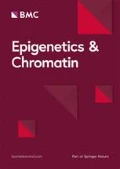Background
Mithramycin (MTR), a clinically approved DNA-binding antitumor antibiotic has been found to cross the blood-brain barrier and is in its preclinical trials in Huntington’s disease (HD) [1]. It improved altered nucleosome homeostasis in HD mice, normalizing the chromatin pattern. It has the ability to rebalance epigenetic histone modifications. The binding properties of MTR with histone proteins have been examined from the perspective of the current proposition from our laboratory to classify small DNA binding molecules in terms of their ability to bind chromosomal DNA alone (single binding mode) or both histones and chromosomal DNA (dual binding mode) [2, 3].
Materials and methods
Chemicals were from Sigma, histones from New England Biolabs, antibodies from Abacm, Active Motif. Spectrofluorimetry, circular dichroism (CD) studies, in vitro histone acetyl transferase (HAT) assay and western blot analysis were employed as experimental tools.
Results
Spectrofluorimetric measurements and CD studies show that MTR binds with micromolar dissociation constant to core histone assembly and its individual histone components. A single isoelliptic point in the CD spectra indicates formation of one type of complex between MTR and histones. Complex formation leads to decrease in molar ellipticity in the far UV CD spectra of core histones. These results led us to investigate the role of MTR as a potential epigenetic modulator. In vitro HAT assays using CREB-binding protein (CBP) HAT domain, a transcriptional coactivator, showed that MTR inhibits H3 K18 acetylation (specifically mediated mark by CBP/p300 in vivo) in H3.3 recombinant histone whereas it induces H3 K18 hyperacetylation in H3.1/H4 tetramer as well as core histones.
Conclusions
MTR exhibits dual binding mode since it binds to histone proteins present in chromatin besides DNA [4]. It alters CBP induced H3 K18 acetylation. In contrast to MTR-DNA interaction, association of MTR with histones does not require obligatory presence of bivalent metal ions. The interaction of MTR with histones hints at a different scenario in MTR-chromatin interaction. Experiments are in progress to address the effect of MTR on other epigenetic marks. The significance of these in vitro experiments would also be examined by performing cell line based experiments. These data would be useful in understanding the mechanism of action of anticancer drugs as well as in designing new-generation therapeutics.
References
Stack EC, Del Signore SJ, Luthi-Carter R, Soh BY, Goldstein DR, Matson S, Goodrich S, Markey AL, Cormier K, Hagerty SW, et al: Modulation of nucleosome dynamics in Huntington’s disease. Hum Mol Genet. 2007, 16: 1164-1175. 10.1093/hmg/ddm064.
Ghosh S, Majumder P, Pradhan SK, Dasgupta D: Mechanism of interaction of small transcription inhibitors with DNA in the context of chromatin and telomere. Biochim Biophys Acta. 2010, 1799: 795-809. 10.1016/j.bbagrm.2010.06.008.
Dasgupta D, Majumder P, Banerjee A: A revisit of the mode of interaction of small transcription inhibitors with genomic DNA. J Biosciences. 2012, 37: 475-481. 10.1007/s12038-012-9211-9.
Mir MA, Majee S, Das S, Dasgupta D: Association of chromatin with anticancer antibiotics, mithramycin and chromomycin A3. Bioorg Med Chem. 2003, 11: 2791-2801. 10.1016/S0968-0896(03)00211-6.
Acknowledgements
This work was funded by Department of Atomic Energy, Govt. of India.
Author information
Authors and Affiliations
Rights and permissions
This article is published under license to BioMed Central Ltd. This is an Open Access article distributed under the terms of the Creative Commons Attribution License (http://creativecommons.org/licenses/by/2.0), which permits unrestricted use, distribution, and reproduction in any medium, provided the original work is properly cited.
About this article
Cite this article
Banerjee, A., Das, C. & Dasgupta, D. Mithramycin interacts with core histones and modulates epigenetic modifications. Epigenetics & Chromatin 6 (Suppl 1), P106 (2013). https://doi.org/10.1186/1756-8935-6-S1-P106
Published:
DOI: https://doi.org/10.1186/1756-8935-6-S1-P106

